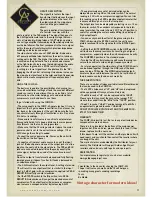
W W W . G O L D E N A G E P R O J E C T . C O M
II
CIRCUIT DESCRIPTION
The signal first enters the input
transformer that balances the input
signal and increase the level, it is
then fed into both the side-chain
circuit and the gain reduction
circuit.
The gain reduction circuit consists
of a resistor in series with the
photo resistor in the T4B module. The signal then goes to
the GAIN potentiometer and to the output stage that con-
sists of two double-triode tubes, a 12AX7 which operates
as a voltage amplifier followed by a 6N6 which operates as
a cathode-follower. The final component in the main signal
path is the output transformer which provides impedance
matching and a balanced output.
The side-chain section uses a12AX7 double-triode and a
6P1 power penthode tube that drives the electro-lumines-
cent panel in the T4B. The higher the voltage the more light
is emitted on the photocells, their resistance decreases
as the light intensity increases, thereby bringing the audio
signal closer to ground in a R1/R2 resistor attenuator
resulting in a lower signal level (the photocell is the “R2”).
Engaging the HF control, ie turning it clockwise, increases
the side-chain signal level in the mid- and high frequencies
which will increase compression of frequencies above 1
kHz.
USING THE COMP-2A
The best way to explore the possibilities of any compres-
sor and how different settings affects the sound of different
sound sources is to experiment. You can also find a lot of
information on the www helping you to understand how
compressors work and how to use them.
To get started with using the COMP-2A:
- The components in the COMP-2A generates heat, it is very
important that it gets adequate ventilation. Do not cover the
top, back or the side panels of the unit. Make sure that air
can circulate freely through all ventilations slots. Do not use
it in hot surroundings.
- Since audio transformers are sensitive to external elec-
tromagnetic fields, try to keep a distance to mains power
transformers in other units as big possible.
- Make sure that the AC voltage selector (above the mains
power socket) is set to the correct mains voltage, 115 or
230V, change the setting if needed.
- Connect the mains power cable. Power on the unit with
the switch on the front panel.
- Connect your line level audio source to one of the input
jacks at the back panel and one of the output jacks to a line
input on the next unit in the signal chain. The TRS and XLR
jacks are connected in parallel so they carry exactly the
same signal, both can be used at the same time in most
cases.
Since the output is transformer balanced and fully floating
towards ground, it doesn’t matter if it feeds a balanced or
an unbalanced input.
- The GAIN control sets the output level. A setting of around
1,5 will result in an output level that is similar to the input
level (= 0 dB of gain) with no compression applied, ie PEAK
REDUCTION set fully counter clockwise.
- Set the BYPASS switch to the IN position, turn PEAK
REDUCTION clockwise until you get the desired amount of
compression, The output level will decrease as compres-
sion increases, compensate that by increasing GAIN.
- The approximate amount of gain reduction can be
diplayed by selecting GR on the meter switch. The normal
reading is 0 VU with no compression applied. You can trim
this reading using the ZERO adjustment potentiometer that
is accessed through a hole in the front panel.
The output level can be displayed by sel4 or +10 on
the meter switch. The numbers corresponds to the refer-
ence level when the meter shows 0 VU. The +10 position is
useful for avoiding the meter needle hitting its end stop at
high output levels,
- You can easily check the effect of the processing in the
COMP-2A by using the BYPASS switch, the unit is com-
pletely removed from the signal path in the BYPASS posi-
tion.
- Setting the LIMIT/COMPRESS switch in the LIMIT position
will increase the compression ratio, resulting in a higher
compression, especially when the unit compresses heavily.
The COMPRESS position is the standard mode.
- Turning the HF control clockwise will make the compres-
sor more sensitive to mid and high frequency content.
- For stereo operation, the side-chain of two COMP-2A units
can be linked together through the LINK jack at the back
panel, using a TRS cable. The MONO adjustment potenti-
ometer can be used to balance the units. An instruction of
the procedure can be found on our web site.
TUBE SUBSTITUTION
There are a number of tubes available from different brands
that can be used in the COMP-2A.
- The 12A7X´s (tube socket “U1” and “U4”) can be replaced
with any equivalent from your favourite brand.
- The 6N6 in socket “U2” can be replaced with a 12BH7.
Please note that you must then move the jumper “TX1”
close to the socket from the “6N6” to the “12BH7” position.
- The 6P1 in socket “U3-6P1” and be removed if a 6AQ5 or
an equivalent is placed in socket “U3-6AQ5”.
DO NOT POPULATE BOTH THE 6P1 AND THE 6AQ5 SOCK-
ETS AT THE SAME TIME!
WARRANTY
The COMP-2A is built to last. But as in any electronic device,
components can break down.
There is a fuse located at the bottom of the mains power
input socket. If the unit dies, please check this fuse. If it has
blown, replace it with a new one.
If this doesn´t help, or if the unit has another problem, it will
need repair and you should then contact the reseller where
you bought the unit.
The warranty terms are decided by the Distributor for your
country. The Distributor will support Golden Age Project
resellers and end users with repairs and spare parts.
REGISTRATION
You are welcome to register your unit at our website:
www.goldenageproject.com
---------------------------
I would like to thank you for chosing the COMP-2A!
I hope it will serve you well and that it will help you
in making many great sounding recordings.
Yours,
Bo Medin
Vintage character for modern ideas!
















